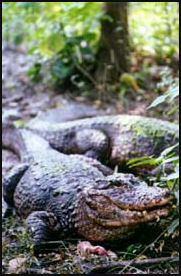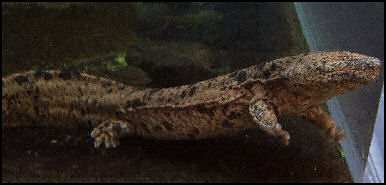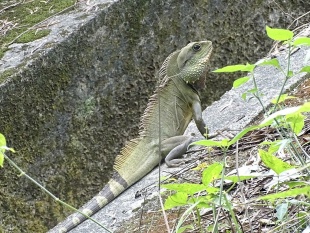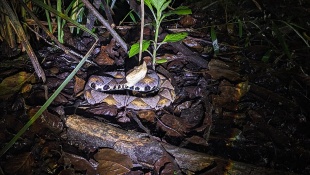INTERESTING REPTILES IN CHINA
Tokay geckos (Gekko gecko) are the largest geckos in China. Their body length can reach 30 centimeters. They live in cracks of mountain rocks, trees, and outside of houses or even indoors. They feed on small birds, insects and small gecko. They can be found in souther Chinese provinces such as Yunnan, Guangxi, Guangdong, Hong Kong and Fujian. Gecko tails easily break off bu can grow back. The scales on their back are like small grains with larger scales arranged in in longitude rows. The scales on their belly are larger and are hexagon -shaped. Their four limbs and claws are strong and flat, and the skin under the limbs are wrinkled, which are beneficial for their climbing on smooth objects. They can change their colors to match their environment. Tokay geckos become sexually mature at age 3-4 and produce one of two eggs from June to July. Their eggs are white and round and the hatch from 92 to 120 days. Geckos have been killed for Chinese medicine. [Source: Center of Chinese Academy of Sciences, kepu.net.cn]
Chinese water dragons (Physignathus cocincinus) are large-sized lizards. Their head can reach 20 centimeters and their tail length can reach 40 centimeters. They reside in trees and bushes in low-altitude humid river valleys in tropical areas and often crawl on bamboo during the summer. They catch insects and young fish etc. They can be found in tropical areas in South Yunnan, Guangdong and Guangxi. They are listed as rare protected animals in Yunnan. In the middle of their back, there is a row of “horsehair” scales, which start from the neck and end in the middle of their tail, which rise up when the they are threatened or surprised. For this reason they are sometimes called "horsehair snake". The color of their body can change to match their surrounding environment, and have been "chameleon" although are not real chameleons. Oriental water dragon are good at swimming. They lay eggs. Since they have a beautiful body color and strange shape, people often catch them out of curiosity. But since they resides in tropical areas, it's very hard for them to survive if they are removed from their original habitat. For this reason their numbers have been greatly reduced.
Water monitors (Varanus salvator) are large lizards. Adult water monitor can have a body length of 2.5 meters; They live in places near mountain streams in tropical and sub-tropical areas and can adapt to all kinds of environment. Their food can change based on their habitat. They can catch fish in water and can also climb on trees to seek food and eat frogs, snakes, birds, eggs of all kinds of birds, mice, insects and other small creatures. They can be found in South Yunnan, Guangdong, Guangxi, Hainan as well as in South and Southeast Asia. They are a protected animal.
Water monitors heads resemble those of snakes. Their purple-colored tongue is forked, thin and long, and goes in and out all the time. Their tongue is similar to that of a snakes and has sensory organs on it. Their neck is thick and their head can move freely. When they fight they use their flat tail as weapon.s They lay 15-30 eggs in dens near riverbanks or hollows of trees close to water. Under natural condition, their hatching period can be as long as a year. Because of hunting and disruptions of their habitat water monitors have suffered great losses.
See Separate Articles:
REPTILES: TAXONOMY, CHARACTERISTICS, THREATENED STATUS factsanddetails.com
LIZARDS: CHARACTERISTICS, SENSES, ODDITIES factsanddetails.com
DRACO FLYING LIZARDS OF SOUTHEAST ASIA: CHARACTERISTICS, BEHAVIOR AND REPRODUCTION factsanddetails.com
GECKOS: CHARACTERISTICS, AMAZING FEET, WALKING ON WALLS factsanddetails.com
INTERESTING GECKOS IN SOUTH AND SOUTHEAST ASIA factsanddetails.com
MONITOR LIZARDS: CHARACTERISTICS, BEHAVIOR, FOOD factsanddetails.com
BIGGEST AND MOST COMMON MONITOR LIZARDS: ASIAN WATER AND BENGAL MONITORS factsanddetails.com
RECOMMENDED BOOKS: “The Chinese Alligator: Ecology, Behavior, Conservation, and Culture” by John Thorbjarnarson and Xiaoming Wang Amazon.com; “The Reptiles of China: Turtles, Crocodilians, Snakes, Lizards” (Classic Reprint) by Clifford Hillhouse Pope Amazon.com; “Snakes of China” ( 2 Volume set) by Zhao Ermi Amazon.com; “Chinese Wildlife” ( Bradt Travel Wildlife Guides) by Martin Walters Amazon.com; “Guide to the Wildlife of Southwest China” by William McShea, Sheng Li, et al. Amazon.com; “Wild China: Natural Wonders of the World's Most Enigmatic Land by Phil Chapman, George Chan, et al. Amazon.com; “Wildlife of China” by China Wildlife Conservation Association Amazon.com; “Wildlife Wonders of China: A Pictorial Journey through the Lens of Conservationist Xi Zhinong” by Zhinong Xi, Rosamund Kidman Cox, et al. Amazon.com; “Mammals of China (Princeton Pocket Guides” by Andrew T. Smith and Yan Xie Amazon.com; “China Red Data Book of Endangered Animals: Mammalia” by Wang Song Amazon.com; “Rare Wild Animals” (Culture of China) by Yang Chunyan, Zhang Cizu, et al. Amazon.com
Chinese Alligators

Chinese alligator Chinese alligators are the smallest crocodilians. They average around two meters (six or seven feet) in length, about half their American counterparts. They are known in China as "tu long," or earth dragon, and may have inspired the dragon myth. The species, also known as the Yangtze alligator, is endemic to eastern China and has traditionally been found in the middle and lower reaches of the Yangtze River and were once found throughout the lakes and rivers in the lower Yangtze basin but now are only found in small areas in Zhejiang and Anhui Provinces about a hundred miles west of Shanghai. [Source: Carol Kaesuk Yoon, New York Times, August 21, 2001]
Chinese alligators live in a colder climate than other crocodilians and are the only crocodilians that hibernate. They usually hibernate in the winter in complex networks of burrows on the banks of their ponds. Chinese alligators are regarded as relatively mild mannered and non-threatening. They prefer living in lowland wetlands but because of development have so few places these days to live they have begun moving to forests and the slopes of hills, which are not suitable for burrowing. Adults can survive in these places buts eggs and young alligators often die if the weather gets too cold.
CHINESE ALLIGATORS: CHARACTERISTICS, BEHAVIOR AND REPRODUCTIONSee Separate Article: factsanddetails.com
Snakes and Snake Stunts in China
Indian pythons (Python molurus birittatus kuhl) are the largest snakes in China, reaching lengths of over seven meters. They live in forests of the tropical and sub-tropical areas, or evergreen broad-leaved forests and bushes near streams or brooks. They can be found in tropical areas in West and South Yunnan, Guangdong, Guangxi, Fujian, Guizhou and Hainan. They have traditionally been killed as threats, pests and for food. They are now regarded as endangered in China.
In an attempt to break a "Guinness Book of World Records" record that no longer exists, two 23-year-old Chinese girls spent 12 days in a room with 888 snakes (8 is a lucky number) in 1995. The stunt was sponsored by the Flying Dragon Amusement Park and Snake Center, and the two girls were chosen because they passed tests which included sleeping with, swimming with, and kissing snakes. Among the snakes were 666 cobras. During their 12 days with the snakes in the 320-square-foot enclosure, the girls jumped rope with long snakes, swallowed and regurgitated small ones and laid under dozens of heavy boas. Their main problem, the girls said, was keeping the 666 cobras from attacking the 222 non-poisonous snakes. "The cobras always wanted to fight with the non-poisonous ones, and sometimes they would try to bite us," one of the girls said. One 150 snakes died from cobra attacks and around 800 snakes had to be replaced over the 12 day period. One of the women survived two cobra bites. In one case her knee swelled up like a grapefruit after being bitten in her sleep. In both cases the girl was able to treat herself with anti-venom and continue the stunt.
In 2016, a woman in China has released hundreds of snakes into the wild as part of a ritual which shows compassion to all creatures. The result was that villagers slaughtered hundreds of snakes fearing they would be bitten by venomous ones. "Originally we gave salvation to more than 200 snakes, but we estimate that now there are over 900!" said the woman, who calls herself "Cool Mandy" on the Chinese microblogging platform Weibo. According to the BBC: “The snakes were reportedly set free in a mountainous area in southwestern Sichuan province and quickly slithered their way to nearby a village. In the ensuing upheaval, its fearful residents caught and clubbed the vermin to death by the dozen, the Shanghaiist website reports. "Villagers said that they have had a few restless nights in the last week," it reports. "For instance, one anxious villager surnamed Lei couldn't help but circle around his house once every hour to make sure it was clear of snakes." [Source: BBC, June 10, 2016]
“The villagers' fears appear to be well-founded. The Chengdu Economic Daily, a local newspaper, reports that at least some of the serpents have been identified as venomous. Releasing captured wildlife is considered a righteous deed that brings good karma in China, says Yashan Zhao from BBC Chinese. The ritual is particularly popular among Buddhists, and normally involves purchasing fish, frogs, birds, turtles, etc. at local markets before releasing them into the wild. But "Cool Mandy's" stint earned her few karma points among Chinese bloggers. "I condemn this releaser, she should be punished, she has created a dangerous situation for the villagers" is a popular view, and one Weibo user wonders: "Why didn't she just release them in her own bedroom?"
RELATED ARTICLES:
SNAKES AS FOOD IN CHINA factsanddetails.com
SNAKES: HISTORY, CHARACTERISTICS, LARGEST, SENSES, FEEDING, BREEDING factsanddetails.com
UNUSUAL SNAKES IN ASIA: FLYING, CARTWHEELING AND TENTACLED ONES factsanddetails.com
Venomous Snakes in China
There are 35 venomous snake species on the land and in the seas of southern China, including keelbacks, kraits, cobras, sea snakes, sea kraits, coral snakes, vipers and pit vipers. Three cobra species can be found inhabit in South China: the Chinese cobra (Naja atra), monocoled cobra (Naja kouthia) and king cobra (Ophiophagus hannah). The Chinese and monocle cobras are one meter to two meter in length and look so similar to each other that positive identification often requires an expert. Both species consume frogs, lizards, rodents and snakes. Five types of sea snake and two amphibious sea kraits live in waters off southern China. [Source: Ben Team, Mom.com]
Kraits are nocturnal hunters. The banded krait (Bungarus fasciatus) is one of the largest krait species and can reach two meters feet in length; the smaller many-banded krait (Bungarus multicinctus) averages about 1.7 meters. Krait venom is one of the strongest snake venoms. Two true vipers make their home southern China: Fea’s viper (Azemiops feae) and the Russell’s viper (Daboia russelli), one of the most bad-tempered and deadliest snakes known. Russell’s vipers eats large rodents and occasionally birds.
Most of of the venomous snakes living in southern China are pit vipers of the genus Trimeresurus:. Mangshan pit viper (T. mangshanensis), The white-lipped pit viper (T. albolabris), Tibetan bamboo pit viper (T. tibetanus), Motuo pit viper (T. medoensis), Grumprecht’s green pit viper (T. grumprechti), Kham Plateau pit viper (T. xiangchengensis), Taiwan mountain pit viper (T. gracilis) and Yunnan bamboo pit viper (T. yunnanensis) have similar biology but inhabit slightly different niches.
The Chinese moccasin (Deinagkistrodon acutus) reaches lengths of 1.55 meters (five feet). Found in southern Vietnam, Taiwan and China, they are the most toxic of the Asian pit vipers. A bite causes immediate swelling, tissue damage and internal bleeding and may be fatal. There is an antivenin. They resemble copperheads are known by a variety of names. See Below. Mamushi (Gloydius blomhoffii) and Likian pit viper (G. monticola) are not common in southern China. The former is found in Japan. The green Stejneger’s bamboo pit viper (Viridovipera stejnegeri) is a striking-looking snake. Scientists working in China are still discovering new species; In 2011 scientists formally described the ruby-eyed pit viper (Protobothrops maolanensis), which lives in China along with the closely related Jerdon’s (P. jerdonii) and brown-spotted pit vipers (P. mucrosquamatus).
RELATED ARTICLES:
VENOMOUS SNAKES: VENOM, PHYSIOLOGY, DEADLIEST SPECIES factsanddetails.com
VENOMOUS SNAKE BITES: ANTIVENOMS, WHAT TO DO AND NOT DO factsanddetails.com
VENOMOUS SNAKES IN ASIA: KRAITS AND RUSSELL'S, SAW-SCALED AND PIT VIPERS factsanddetails.com
COBRAS: CHARACTERISTICS, VENOM, BITES, TREATMENTS factsanddetails.com
COBRAS IN ASIA: SPECIES, CHARACTERISTICS, VENOM factsanddetails.com
INDIAN COBRAS: CHARACTERISTICS, BEHAVIOR, VENOM, BITES factsanddetails.com
KING COBRAS: CHARACTERISTICS, BEHAVIOR, VENOM, HUMANS factsanddetails.com
Chinese Moccasins
Chinese moccasins (Deinagkistrodon acutus) are venomous snakes found in southern China and some parts of Southeast Asia. They reaches lengths of 1.55 meters (five feet) and have the most toxic bite of the Asian pit vipers. A bite causes immediate swelling, tissue damage and internal bleeding and may be fatal. There is an antivenin.
They are known by various other names including hundred-pacer, sharp-nosed viper, snorkel viper, Chinese copperhead, five-pacer, hundred-pace snake, long-nosed pit viper, sharp-nosed pit viper, and hundred-pace pit viper. The snake is the sole member of the genus Deinagkistrodon and has been an object of veneration by indigenous Taiwanese peoples. [Source: Jennifer Vicente, Animal Diversity Web (ADW) /=\; Wikipedia]
Chinese moccasins are found in Southeastern China in the provinces of Anhui, Zhejiang, Fujian, Hubei, Jiangxi, Guangxi, Guangdong, extreme southeastern Sichuan, Yunnan, northern Vietnam, and central and southern Taiwan. They prefer moist, shaded habitats in montane forests and foothills, but are also found in agricultural areas, at elevations from 200 to 1400 meters (656 to 4593 feet). They hang out among rocks and in vegetation along valley streams. They occur near farm houses where they like to hide in dark places and hunt for rodents. Chinese moccasins have been known to enter homes in search of food and bite people.
The vemon of Chinese moccasins has been used for centuries as a traditional remedy for rheumatiod arthritis and pain in tendons and bones. More recently, the venom's anticoagulation properties have been harnessed in hemostatic and thrombolytic drugs, which are widely used to prevent harmful blood clotting in stroke victims.
See Separate Article: CHINESE MOCCASINS: CHARACTERISTICS, BEHAVIOR, VENOM AND BITE factsanddetails.com
Pythons in China
Reticulated pythons and Burmese pythons are found in China. Burmese pythons (Python bivittatus) make up one of the largest species of snakes. They are native to Southeast Asia and can live to be 25 years old. Sometimes kept as pets, they reach lengths of 6.5 meters (21 feet) and achieve the thickness of a telephone poll. Burmese pythons are known to feed on almost any living creatures. They have been observed eating full-grown deer and crocodilians.
The reticulated python (Malayopython reticulatus) of Southeast Asia is the longest snake in the world and the third heaviest after green anaconda of South America and the Burmese python. On average, reticulated pythons reach 6.25 meters (20.5 feet). One measuring 6.95 meters (22.8 feet) is the longest, reliably-measured wild reticulated python. Larger sizes have been reported, with some claims of ones over 10 meters (33 feet) in length, but these are considered controversial or unreliable. A captive reticulated python named "Medusa" was reported to measure 7.67 meters (25.2 feet) and weighed 158.8 kilograms (350 pounds).
RELATED ARTICLES:
PYTHONS: CHARACTERISTICS, HUNTING, PREY factsanddetails.com
BURMESE PYTHONS: CHARACTERISTICS, SIZE, BEHAVIOR, PREY, REPRODUCTION factsanddetails.com
RETICULATED PYTHON: CHARACTERISTICS, BEHAVIOR, SIZE, PREY, REPRODUCTION factsanddetails.com
PYTHON ATTACKS ON HUMANS factsanddetails.com
Interesting Amphibians in China
The spiny newt of China can produce poison instantly by forcing its ribs outwards with such force that it causes the skin to break and release poison from the poison glands under the skin. Some newts are referred to as dragons because of their strange-looking exterior gills.
An Asian Gold Toad survived a trip in a cargo container from China to Cape Town, South Africa after jumping into a porcelain candlestick made in China. The trip by ship lasted many weeks and covered thousands of kilometers across the Indian Ocean. The amphibian, became famous in South Africa, is believed to have survived the trip by hardening its skin to prevent it drying out and also slowing its breathing and heart rate, methods that help the species survive in times of drought. [Source: Christopher Torchia, Associated Press, December 22, 2012]
Wrinkled frogs (Rana rugulosa) are quite large. The sizes of female and male frogs are different. Their preferred habitats are rice fields and ponds. They hide in dens during the day and come out to seek food in the night. They eat other frogs, tadpoles of other frogs, spiders, insects and young fish. There are perpendicular skin protrusions of different lengths nn their back and body, whose distribution are quite even. On their back, there are also irregular deep color strips. The stripes on their four limbs are quite visible, which looks like tiger stripes — wrinkles to Chinese — hence their name. Wrinkled frogs can be found in tropical areas in southwest and south China. Their number have been greatly reduced by hunting. They are regarded as a threatened species. [Source: Center of Chinese Academy of Sciences, kepu.net.cn]
Yunnan Mustache Toads (Vibrissaphora ailaonica) live in primary forests at an elevation between 800 to 2600 meters, where vegetation is varied, the environment is humid and evergreen broad-leaved forests block sunshine at ground level. They eat snails, worms and frogs. Yunnan mustache toad have 10-16 thorn-like protrusions on the edge of their upper lip, which look sort of like a mustache, the source of their name. They are also called the "bearded frog". The eyes are a rainbow of color, with the upper part blue and the lower part black. Most of the time they live on land in groups. During the mating seasons, they enter water and lay their eggs in streams where the water is clear and calm. About 40 days later, small tadpoles emerge. There are high numbers of tadpoles; but their survival rate is low. They can be found only in Ailao Mountain and Wuliang Mountain areas of Yunnan. They are protected animals in Yunnan.
Chinese Giant Salamander

Chinese giant salamander The Chinese giant salamander is the largest of all amphibians Part of a lineage stretching back 170 million years and found in rivers and streams, they are regarded as “living fossils”. They can weigh up to 63.5 kilograms (140 pounds). Locals call them "baby fish" because they make a noise that sounds like a crying baby during the mating season. Chinese giant salamanders can be found in in mountain streams of northeast and southeast Yunnan and 17 provinces of China. Particularly large ones have been found in the Qingshui and Wuyang rivers the in central Guizhou.
Chinese giant salamanders (Andrias davidianus) have total body and tail length of 1.8-2.0 meters and weigh 20-25 kilograms. They reside in mountain streams at an elevation between 200 to 1500 meters, where the waters are rapid and clear and where there are many cracks and holes among rocks to hide in. They don't seek and attack prey but rather open their mouth to wait for their prey to enter their mouth, and then slamming it shut. and like to eat fish, crabs, frogs, snakes and other aquatic animals. [Source: Center of Chinese Academy of Sciences, kepu.net.cn]
Chinese giant salamanders have a big head, on which there are apparent grains. Chinese giant salamander have a large mouth, but their eyes and nostril are very small. Their tail is flat and their skin is soft and smooth. Normally, their skin color is brown and they have no scales at all. Their four limbs are short and fat. Their mating season is from June to August each year. Females lays their eggs on rocks which are then fertilized by the male’s sperm. Young salamanders hatch quickly from their eggs — within 21 days naturally — but grow very slowly.
What are the locals doing to preserve to these rare animals? Eating them of course. Giant salamanders are regarded as a delicacy and their flesh is considered delicious. Their habitats have been greatly reduced and they are regarded as a threatened species. However they are bred in large numbers under license for human consumption in China.
See Separate Article: GIANT SALAMANDERS IN CHINA: FARMS, FOOD AND DECLINE IN THE WILD factsanddetails.com
Image Sources: 1) Kostich; 2) Wild Alliance; 3) AAPA; 4) Tooter for Kids; 5, 6) China Alligator Fund; 7) Blogspot; 8, 9) China Science Academy; 10 Environmental News11) CNTO, Wikimedia Commons
Text Sources: Animal Diversity Web animaldiversity.org ; National Geographic, Live Science, Natural History magazine, CNTO (China National Tourism Administration) David Attenborough books, New York Times, Washington Post, Los Angeles Times, Smithsonian magazine, Discover magazine, The New Yorker, Time, BBC, CNN, Reuters, Associated Press, AFP, Lonely Planet Guides, Wikipedia, The Guardian, Top Secret Animal Attack Files website and various books and other publications.
Last updated March 2025


